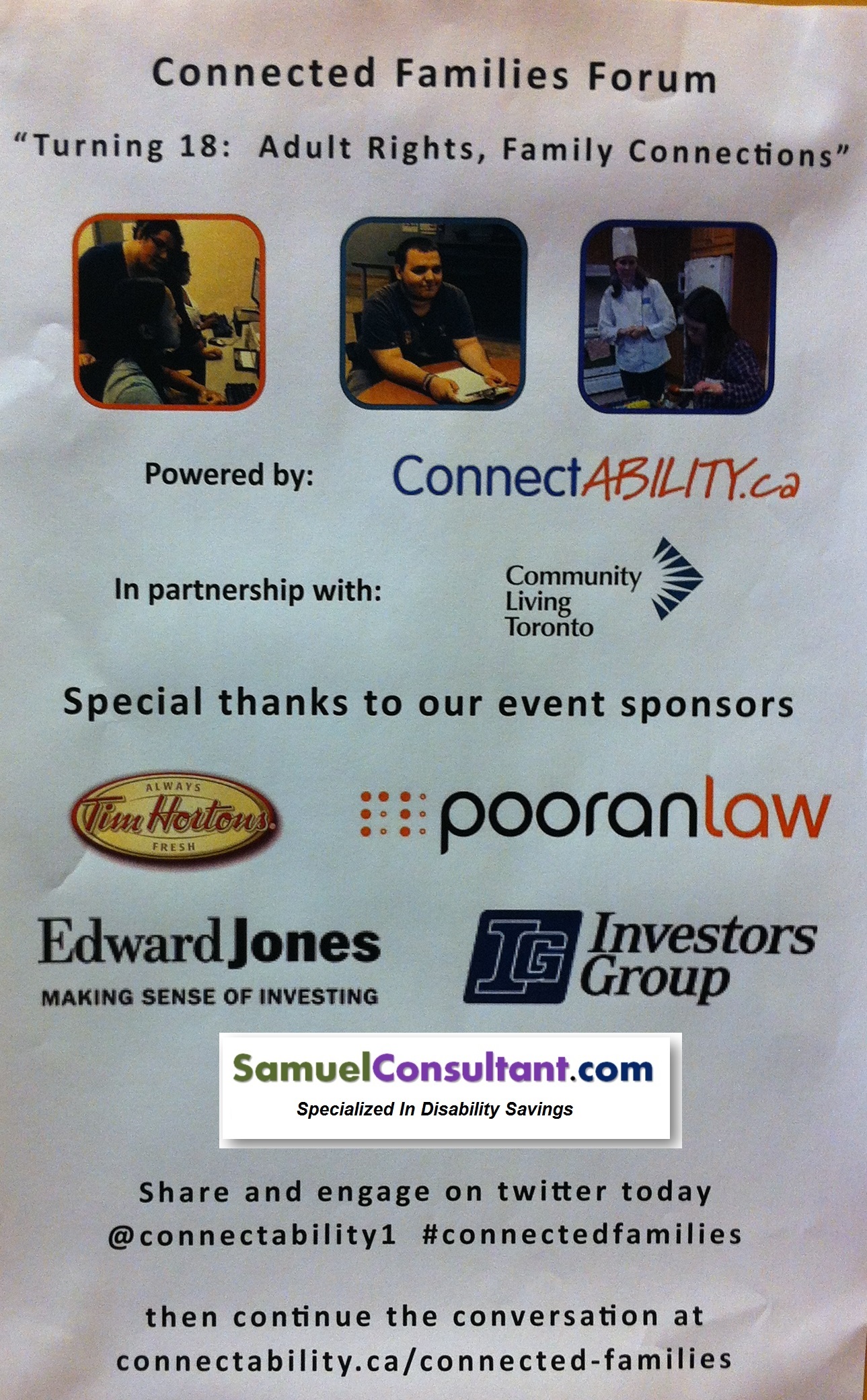Last Saturday, I attended an event called the “Connected Families Forum” hosted by Community Living Toronto. This was a full day forum that provided valuable information and wonderful networking opportunity for families with intellectual disability. It was my second year in participating to this event, and throughout the day I did learn a lot from different speakers. For example, an exercise was done to reduce stress with proper breathing technique, while Brendon Pooran, the principal lawyer at PooranLaw, has presented what are the decision-making rights of intellectually disabled adults and how it can be practically applied into daily lives. I also had the privilege to share my knowledge on the Registered Disability Savings Plan (RDSP) with many families in there. Throughout the many conservation I had on that day, below are some common questions I received the most , so let’s go through one by one now:
Questions #1: Who can setup a RDSP account?
The Registered Disability Savings Plan is for Canadians with prolonged disabilities. To setup the RDSP account, the beneficiary will have to be:
- Approved with the disability tax credit
- Under the age of 60
- Have a valid SIN
- Resident of Canada
For more details about the disability tax credit, please visit: https://samuelconsultant.com/disabilitytaxcreditcanada/
Question #2: Who can be the RDSP account holder?
If the beneficiary is not legally competent to sign a contract, (this could be due to minor age or the disability condition), a qualifying family member can establish an RDSP for the beneficiary. The current definition of a qualifying family member includes only “spouse, common-law partner or parent”. If anyone other than the qualifying family member wants to setup a RDSP account for the beneficiary, they will have to go through a formal process of being named as the guardian or legal representative. On the other hand, contribution is less restricted, as anyone can make contributions to the RDSP as long as there is written consent from the account holder.
Question#3: How can I maximize the matching grant from the government?
The Government provides the Canada Disability Savings Grants (CDSG) to match your contribution. The matching rates will differ according to the net family income. For example, according to the 2013 matching rates, the maximum annual CDSG is:
- $3500 for family net income NOT over $87123
- $1000 for family net income over $87123
If the disability tax credit is approved years ago, and no contribution had been made to the RDSP account. It is possible that there are carried forwarded matching grants, you may obtain them by increasing your contribution. However, in any given year, even with the carried forward matching grants, the most CDSG the government will provide is $10,500. Since there are many different factors to consider when calculating the amount of contribution needed to maximize the matching grants, the simplest way is to contact the “Disability Savings Grants & Bonds” department from the government.
For more details about the Canada Disability Savings Grants, please visit: https://samuelconsultant.com/rdspgrant/
Question#4: When can the money be withdrawn from the RDSP account?
Although one may withdraw the funding within the RDSP at anytime, it might not be in the best interest of the beneficiary. The reason is when there is a withdrawal, there will be clawback on the government grants and bonds that are received in the preceding 10 years. The amount of clawback will be prorated according to the amount of withdrawal. Unless under extreme circumstance where the beneficiary has been certified by a physician that the life expectancy will be very short (not beyond five years), one should consider waiting 10 years after the last date in receiving the government grants and bonds to begin the withdrawal.
Question #5: How many RDSP account can I have?
Unlike other registered accounts (i.e.: RRSP, RESP, TFSA), currently, you may only have one RDSP account. I guess it would be too difficult to do record keeping for the grants and bonds if the government allows more than one account.
Question#6: Can I transfer my existing RDSP?
Yes, you can transfer your RDSP account between different financial institutions. In fact, many of my clients has transferred their RDSP accounts from other financial companies to our brokerage, so I can personally manage for them. However, do NOT simply withdraw the money on your own, as this will lead to clawback of the government grants and bonds. There is a standard RDSP transfer form (code: HRSDC EMP5499). By filling this, this will avoid having clawback of the government grants and bonds. Of course, you may contact me for further details at anytime.
Question #7: How can you help me in my RDSP planning?
I specialized in the disability savings plan. Below are what you can expect when working with me:
- Before your disability tax credit is approved, you will receive free guidance from me on how to apply for it. (Note that unlike other agency, I do not take a cut of your tax return.)
- Once your disability tax credit is approved, I will prepare all the documentation in setting up the RDSP account for you.
- I will assist you to apply for the disability savings grants and bonds from the government.
- We will sit down and discuss what are your investment goals and risk tolerance. I then design an investment portfolio according to your needs.
- Your money will be managed daily by investment professionals.
- I will provide ongoing financial advice and management of your account. This ensures the financials strategy is aligning with your goal and you do receive the government grants and bonds that you are entitled to.
Disclaimer: the above are only for general understandings of the RDSP, not intended to provide any advice. The details might not be applicable to everyone as individual situation may be differed from one another.



